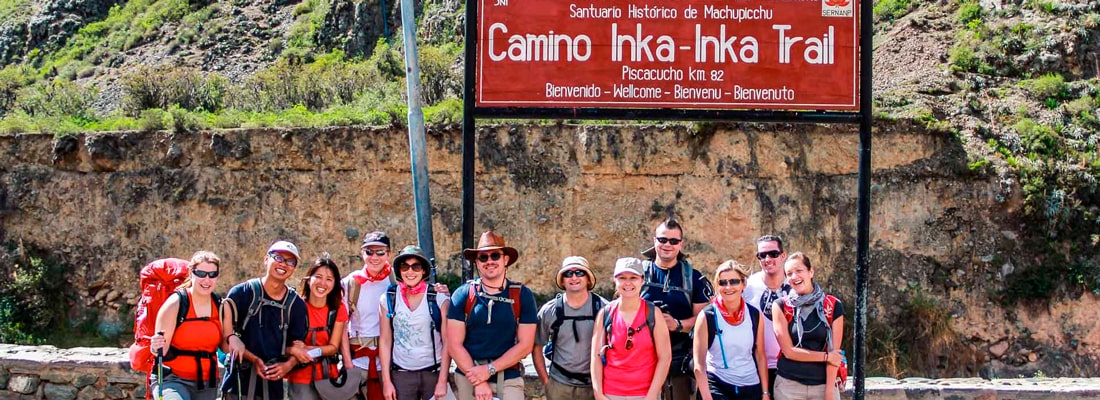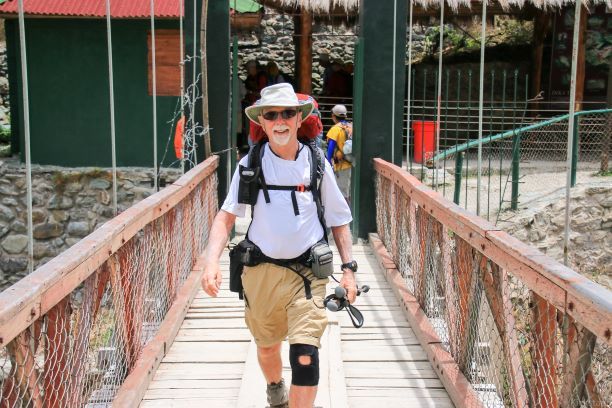Have you ever imagined dark green valleys, lost cities, and peaks surrounded by mist? Travelling the Inca Trail in Peru is undoubtedly a rite of passage, it will be the adventure of a lifetime. The best logistics and preparation for this trail is what this article will guide, describing the essential information to complete the Inca Trail and finish your trek in MachuPicchu.
There are several ways to get to the mythical citadel of Machu Picchu. You can imagine yourself walking the Inca Trail and reaching the famous ruins at sunrise.
It is a mythical trail, following in the footsteps of the ancient Incas, the circuit of the Inca Trail begins at the exit of Cusco, following the paths that the Incas used to follow to Machu Picchu. It is one of the two access roads that give access to the archaeological site of MachuPicchu.


Important: places are limited in this circuit; We recommend booking several months in advance.
- When to go to the Inca Trail?
- General recommendations for walking:
- Frequently asked questions about the Inca Trail
- When is the best time to do the Inca Trail?
- Is Inca Trail open all year round?
- Is the Inca Trail allowed for people of all ages?
- How many people participate in an Inca trail group?
- Can I reserve Inca Trail with a private group?
- Is it difficult to do the Inca Trail?
- Can I book the Inca Trail directly in Cusco?
- What to take to the Inca Trail?
- How long does the visit to Machu Picchu last after the Inca Trail?
- What are the other alternatives if I don’t find availability for the Inca Trail?
When to go to the Inca Trail?
We have scheduled departures all year round, except February, when the Inca Trail is closed for maintenance and the rain discourages any traveller. June to August is the coldest and driest period, therefore it is the most indicated. With the right preparation and the right equipment, you can choose any month that the trail is accessible.
To avoid crowds of tourists, the months before and after the rainy season are recommended: from March to May (lush vegetation, with many orchids and birds) or from September to November.
General recommendations for walking:
Even with a light backpack, this hike requires good form. In addition to regular exercise, prepare for long walks in the weeks leading up to departure, which will also allow you to test your equipment.
Everything must be tested before departure. On the road, the heat and altitude can be a problem. Do not rush, adopt a reasonable pace and everything will be fine.
Tour reservation:
Book at least four months in advance for dates between April and August. For the rest of the year, you can get a licence in a few weeks, but there is no guarantee. Permits are issued only by authorized agencies. However, you can check availability.
Consider a 5-day hike for a slower pace and more time to enjoy nature and the ruins. Other advantages would be the less crowded camps and the possibility of spending the third night in the most spectacular of them: Phuyupatamarka, at 3,600 m above sea level.
Take the time to explore all the possibilities, you won’t regret it. Also take out international travel insurance to cover this type of activity.
Regulations and registration during the tour:
In the Cusco region, the Inca Trail is the only trek that cannot be done independently. You must hire an authorized agency. Prices range from $ 500 to $ 750 or more.
Every day, only 500 people (including guides and porters) can start the tour. Licences are issued on a first come, first served basis. You need to provide your passport number to obtain it and present it at checkpoints along the way. If you present a new passport, this can be a problem.
Licences are not transferable, name changes are not accepted.
Choose an authorized agency for Inca Trail:
While it may be tempting and practical to book your route ticket quickly and begin your next preparations, it’s best to carefully consider your options before committing to payment.
If price is your first criterion, remember that cheaper agencies sometimes cut costs by paying fewer guides and porters. Other risks include poor quality equipment (loose tents, for example) and indifferent guides.
Looking for higher prices does not always mean getting the best, international tour operators take their margins and subcontract the service to Peru with Cusco agencies. Ask if the guide is fluent in your language, the size of the group, the transportation used and the list of services included. Be sure to include tent, food, cook, entrance to the MachuPicchu citadel, and return by train.
In the case of a special diet, clearly indicate this before departure, as well as allergies. Vegetarians should expect plenty of quinoa and lentils.
Chargers for group equipment (tents, food, etc.) are also provided. You will be in charge of carrying your personal belongings, including the sleeping bag, unless you pay an additional charge (approximately $ 50 per day for 10 kg).
Meeting travelers from all over the world is one of the best advantages of group hikes. Remember that everyone has their own rhythm and that living together requires some commitments.
If you prefer a more exclusive service, you can arrange a private tour with an independent licensed guide (USD 1,500-2000 / person). For a group of six or more travelers, this can be cheaper than the regular trail. Prices vary a lot, feel free to search and compare.
The working conditions of the porters are a big problem in Cusco. The Ministry of Labor sanctions agencies through fines or withdrawal of licences for violating these laws.
Frequently asked questions about the Inca Trail
When is the best time to do the Inca Trail?
The dry season (from April to October) presents good weather conditions for the Inca Trail. The walk during these months must be scheduled in advance. During the rainy season (November to March), rainfall and river flow are more abundant. So consider wearing waterproof hiking clothes and boots (or raincoats).
Is Inca Trail open all year round?
No, the Inca Trail closes during the month of February. This is due to the maintenance and cleaning service performed during this month.
Is the Inca Trail allowed for people of all ages?
The Inca Trail is allowed for people of all ages. Parents are responsible for the integrity of their children. The elderly should consult a doctor before taking the walk.
How many people participate in an Inca trail group?
Each group of tourists on the Inca Trail should not exceed 14 people. The guides are responsible for each group.
Can I reserve Inca Trail with a private group?
Yes, tourists travelling together can book the Inca Trail with a private group. The cost is higher than the group walk. However, the number of tourists in the exclusive group decreases even more.
Is it difficult to do the Inca Trail?
The Inca Trail is considered of medium to moderate difficulty. The 4 days and 3 nights of hiking are intense for the first days, but diminish as the end approaches. The first reward is to see Machu Picchu from a unique and special place at the end of the walk.
Can I book the Inca Trail directly in Cusco?
Due to high demand, it is only possible to book the Inca Trail online and in advance through a qualified agency. Once in Cuzco, it is only possible to book alternative tours to the Inca Trail.
What to take to the Inca Trail?
The maximum weight allowed for luggage on the Inca Trail is 5 kilos per person. It is recommended to bring water, a change of clothes, sunscreen, sunglasses, toilet paper, sleeping bag, toiletries, raincoat, water purifier, extra money and personal effects in a hiking backpack.
How long does the visit to Machu Picchu last after the Inca Trail?
The visit to Machu Picchu, at the end of the Inca Trail, takes place in the morning (from 6 am to 12 pm). Unlike other visitors, access is through the Porta do Sol (Intipunku), the ancient entrance to the wonder of the world used by the Incas.
What are the other alternatives if I don’t find availability for the Inca Trail?
If the Inca Trail is no longer available on the desired day, you can start the trek to Machu Picchu by the Salkantay Trail. Another option is the trail through the village of Lares, the Inca jungle or known as the Short Inca Trail (duration of only 2 days).


